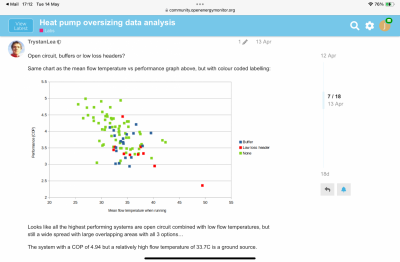British Gas versus Octopus: Two possible heat pump routes - how to evaluate them?
Posted by: @heacolPosted by: @jamespa@JamesPa Do you tell your surgeon where to cut? I think not, however when things go wrong, and if they did listen to you, they would still get the blame and hold liability, you would not. If you do not believe the expert and do not like what you hear, try another and take your chances, usually you get what you pay for. If the installation is not perfect, there is always a trade-off.Posted by: @lucia
Personally I'm fed up with heat pump installers telling me what trade offs I should make. It shouldn't be their choice, it should be mine and, so long as I'm well informed, (hopefully by them) I should be able to make it and installers should respect that, just as I respect their right not to quote.
I have walked away from many customers who think they know better, sometimes the job is not worth the hassle.
No, but I do reserve the right to decide whether I am treated or not, and to request the surgeon to explain the trade offs (which good ones do) if there is more than one treatment option.
As I say I respect the right of the installer not to quote, but they should in return respect my right to decide what trade offs to make, even if they decline to quote for some of them or only offer one. What they shouldn't do is arrogantly assume that I am incapable of making my own choices when presented with the facts. There are almost always a range of solutions to any problem, and if they are in fact experts they will be able to tell me what the trade offs are. If they cant then they are not actually experts, and if they can but wont then they are either being arrogant or are presumably motivated by their own self interest to withhold information that would help me make an informed choice (and ironically, if they are any good, is very likely be much more confident with their offer).
Let me offer two simple analogies.
- There are many types of shopping bag from a very cheap use it once paper bag to a relatively expensive bag that will last many years. Both are valid solutions to the problem of how to get shopping hone. Both have their place. I'm free to choose and none is 'best'.
- Similarly there are many models of car. All perform the basic function of getting you from A to B but they have different trade offs in terms of comfort, features, fuel efficiency, pose value etc. Again I'm free to choose and none is 'best'.
In both cases there is more than one viable solution each of which has their place (and of course lots of non-viable fantasies which combine features in a way that is impossible and so the market doesn't produce).
Heating is no different.
4kW peak of solar PV since 2011; EV and a 1930s house which has been partially renovated to improve its efficiency. 7kW Vaillant heat pump.
Posted by: @heacolPosted by: @jamespaPosted by: @heacolGenerally, the difference between a 45Deg C design and a 50 Deg Desing will be a 40-70% increase in the electricity bill. It is not as simple as most make it out to be.
If this is the case we need to see the evidence and understand the reasons as it's completely at odds with the manufacturer data.
And if it is the case then it implies that a small error in a WC curves will have a similarly devastating impact (1C error = 8-18 percent degradation in performance)
Finally if going from 50 to 45 saves 40-70%, can I save another 40-70% by going from 45-40.
Whilst absolute SCOP figures might not be accurate, you would expect the comparative figures to be closer.
What evidence do you have for your assertions please and what is the physical explanation? This is clearly of massive importance if what you assert is true.
Posted by: @heacolI will give you a clue and only 1 of many reasons, for every 1 Degree you move the flow temperature up from source (outside temperature), you add between 2.5 and 3% to the electricity bill. This is compounded and not linier as you assumed, hence the significant increase at higher temperatures.
If its 2-3% for each degree (which I believe because its what the data sheets say) then how does it become 40-70% for 5 degrees? 1.03^5 (ie compounded) is 1.16 ie 16%
Posted by: @heacolHeat pumps are exceptionally complex machines. Whether you believe my 30 years of experience is of little consequence to me, there are papers I have written, published here that show the complexity of heat pump and system design. Obtaining good performance with a heat pump is not simple, there are many thousands of variables that change continually in real time, to consider, however if relatively simple rules are followed, there is a good chance, with good equipment that does most of the work for you (not many available), a high level of performance and comfort can be achieved. If you compromise, you WILL pay the price.
I didnt dispute that, I didn't suggest that good design was anything other than vital and nor did I question that 30 years experience leads to good design, and nor would I dispute that a simple set of design rules, which is probably very appropriate for large companies, is a good way to ensure good designs.
However we are focussing here on the effect of one variable only namely flow temperature, and you are apparently claiming that a 5C change in FT equates to a 40-70% change in efficiency. All I am doing is asking what the evidence and physical explanation is for this.
If, of course, you are instead claiming that a good 45C design (such as one following your rules) is 40-70% more efficient than a bad 50C design, then that would be a very different claim. There is no reason to question this as this is not inconsistent with manufacturer data, and indeed there is plenty of evidence, at least in general terms, from unhappy customers on this forum that such differences can occur (between good and bad designs) as well as several plausible explanations.
4kW peak of solar PV since 2011; EV and a 1930s house which has been partially renovated to improve its efficiency. 7kW Vaillant heat pump.
https://community.openenergymonitor.org/t/heat-pump-oversizing-data-analysis/25971/7
Here’s a good demonstration of the variation with buffer or 4 port that @heacol is referring to. Possibly better posted in the very long llh thread.
it becomes part of the performance range.
An engineer’s approach to the issue, which coupled with close reading of performance data sheets gives a wide range of performance.
2kW + Growatt & 4kW +Sunnyboy PV on south-facing roof Solar thermal. 9.5kWh Givenergy battery with AC3. MVHR. Vaillant 7kW ASHP (very pleased with it) open system operating on WC
One of the main determining factors in heat pump efficiency is the ratio between the heating capacity of the heat emitters in relation to the actual heat loss.
Doubling the heating capacity of the heat emitters will allow a heat pump to meet the heating demand at a much lower Leaving Water Temperature (LWT).
Conversely, increased insulation to improve household thermal efficiency will also allow a heat pump to meet the heating demand at a lower LWT.
Of course the ideal scenario would be to do both if finances allow.
Posted by: @derek-mJames I thought that you would have realised by now that heat pumps are much too complex for us common folk to understand.
Shame on you. 😋
I shall consider myself duly reprimanded. I don't really do emoji so Ill opt for the simplest 😀
4kW peak of solar PV since 2011; EV and a 1930s house which has been partially renovated to improve its efficiency. 7kW Vaillant heat pump.
Posted by: @heacolGenerally, the difference between a 45Deg C design and a 50 Deg Desing will be a 40-70% increase in the electricity bill. It is not as simple as most make it out to be.
From our personal experience, this tallies up to a point, irrespective of what the documentation for our heat pump says. For three years, our system ran exclusively on a 45°C set point for reasons I have already explained numerous times in different posts, but it boiled down to installer laziness and a poorly designed system. When we finally established that our heat pump could run WC (despite being told by the manufacturer and installer it wouldn’t), our average flow temperature was between 33-40°C, and we saw our electricity consumption drop by well over 50%.
Given the ramp up to a higher (less efficient) flow temperature range, if we ran exclusively at 50°C from 45°C, I would imagine our electricity consumption would probably be more than 50% at mild temperatures, let alone cold winters.
Get a copy of The Ultimate Guide to Heat Pumps
Subscribe and follow our YouTube channel!
Not wanting to hijack Lucia’s post, I’d like to pose a question. If you had two identical heat pumps, one poorly installed and one properly installed, would they consume the same amount of power if both were set to run at the same set point temperature of, say, 45°C?
Get a copy of The Ultimate Guide to Heat Pumps
Subscribe and follow our YouTube channel!
Posted by: @editorNot wanting to hijack Lucia’s post, I’d like to pose a question. If you had two identical heat pumps, one poorly installed and one properly installed, would they consume the same amount of power if both were set to run at the same set point temperature of, say, 45°C?
It very much depends on what is meant by poorly installed and correctly installed. If you mean buffer tank or no buffer tank or PHE or no PHE, then of course this could have a serious effect upon overall efficiency. The size of the heat emitter capacity will also have an effect, as would balancing or not balancing the system, since you will not be comparing like for like.
As with your own system it was set to operate at a fixed LWT of 45C, which meant that for much of the time the heat pump would not be operating at optimum efficiency and at times would actually be cycling. Then changing the system to operate in WC mode means that you are once again not comparing like for like.
@derek-m, thank you for your reply, which highlights, to a degree, the point I’m trying to make. Perhaps I’m struggling to articulate the dilemma I have in my mind. Essentially, I am not asking which system is more efficient in terms of overall performance, heat output or comfort. My question focuses solely on electricity consumption under specific conditions.
Given two identical heat pumps, one installed well and the other installed poorly (with a buffer tank, for example), and both operating at a fixed set point temperature of 45°C in the same outdoor conditions, would they consume the same amount of electricity?
If both systems are running continuously at 45°C, would the poorly installed system with a buffer tank end up consuming more electricity compared to the well installed one? If anything, the better installed system might cycle more under these set point temperatures. But if neither cycles, and the outdoor conditions are cold enough to keep the heat pumps running to continuously satisfy the flow temperature, would the running costs be the same?
Get a copy of The Ultimate Guide to Heat Pumps
Subscribe and follow our YouTube channel!
This: one factor to consider is those heat pump controllers which have a degree minute function to limit cycling at low demand versus those that don’t. Manufacturers with degree minute functionality in their controllers include Nibe,Vaillant and Stiebel Eletron and perhaps some others. The function may be termed something different by the various manufacturers - for example Stiebel Eletron call it Kelvin Minutes
That thread is very helpful even though I don't understand much of it. But the bit I've quoted explains something no one talks about but obviously impacts the running costs for mid season weather conditions, which down here in the SW is the bulk of the year. Please correct me if I'm wrong. 😁
My understanding of the situation you are describing Mars would be that the poorly designed system with the buffer tank would have flow and return water mixing in it. This would effectively mean the circulating water temperature would be lower than that of the well designed system. To compensate for this the flow temperature would need to be raised hence using more electricity.
House-2 bed partial stone bungalow, 5kW Samsung Gen 6 ASHP (Self install)
6.9 kWp of PV
5kWh DC coupled battery
Blog: https://thegreeningofrosecottage.weebly.com/
Heatpump Stats: http://heatpumpmonitor.org/system/view?id=60
-
Daikin Octopus installation update - I saw my first defrost. 😍😂
2 months ago
-
Are Octopuses Slowing Consumer Adoption of Heat Pumps?
4 months ago
-
Vaillant arotherm plus heat pump frost protection
11 months ago
-
Daikin Error Code 7H05
1 year ago
-
Vaillant aroTHERM plus not level or flat - what base is best under an external unit?
1 year ago
- 26 Forums
- 2,360 Topics
- 53.5 K Posts
- 237 Online
- 6,026 Members
Join Us!
Worth Watching
Latest Posts
-

Outlandish, I'll agree, and not one I'll pursue given t...
By Majordennisbloodnok , 9 minutes ago
-
RE: Mitsubishi Ecodan R290 10kW performance
Interesting. Thanks for the info.That would explain th...
By Sheriff Fatman , 33 minutes ago
-
RE: My Powerwall 3 Consumes 3-4 kWh/Day in Self-Consumption: Is This Normal?
@f1p Might be normalmy numbers 3+ year old powerwall 2,...
By ksim , 3 hours ago
-
RE: New Fogstar 15.5kWh upright solution
SITREP #5 (I think) Milestone completed toda...
By GGW , 14 hours ago
-
RE: Octopus Cosy Heat Pump Owners & Discussion Thread
The FT levels off at either the set point OR the minimu...
By AndrewJ , 14 hours ago
-
RE: MyVaillant Connect Regular Disconnect
Thanks. Yes, if the time is consistently 11pm every nig...
By buckwem , 15 hours ago
-

RE: Speedcomfort radiator fans
My take on Speedcomfort radiator fans: If anyone w...
By Mars , 20 hours ago
-
RE: Midea ASHP – how to set weather compensation
@pash44pump I have yet to come across any Clivet or Mid...
By benson , 21 hours ago
-
RE: Who's your electricity provider and what's your tariff?
@transparent Thanks, this helps. Could it be that St...
By Batpred , 21 hours ago
-
RE: Clivet ASHPs and weather compensation
Simon did share a lot of very helpful advice. On furthe...
By ambris , 21 hours ago
-
RE: Home Assistant vs ESPAltherma.
@majordennisbloodnok Thanks very much.
By Ubert767 , 22 hours ago
-

RE: Setback savings - fact or fiction?
I could, but I think we can do better, by plotting hour...
By cathodeRay , 2 days ago
-
RE: Advice on internal circulation pump noise
Extend the primary branch and make sure you have more t...
By ASHP-BOBBA , 2 days ago
-

RE: External pipework insulation
Oh Dear! that's appalling pipe work, should've been in ...
By dgclimatecontrol , 2 days ago
-

RE: Jokes and fun posts about heat pumps and renewables
By Morgan , 2 days ago
-

RE: Controlling Daikin Altherma via P1P2 and Home Assistant
On the contrary, @toodles, that’s a lot of help. I’d ne...
By Majordennisbloodnok , 2 days ago
-

Parsnip, Bacon & Coconut Milk Soup
First let me say, I am only a cook because I am human a...
By Toodles , 3 days ago
-
RE: Electricity price predictions
Ben Watts posted on LinkedIn that he had updated this w...
By Judith , 3 days ago






